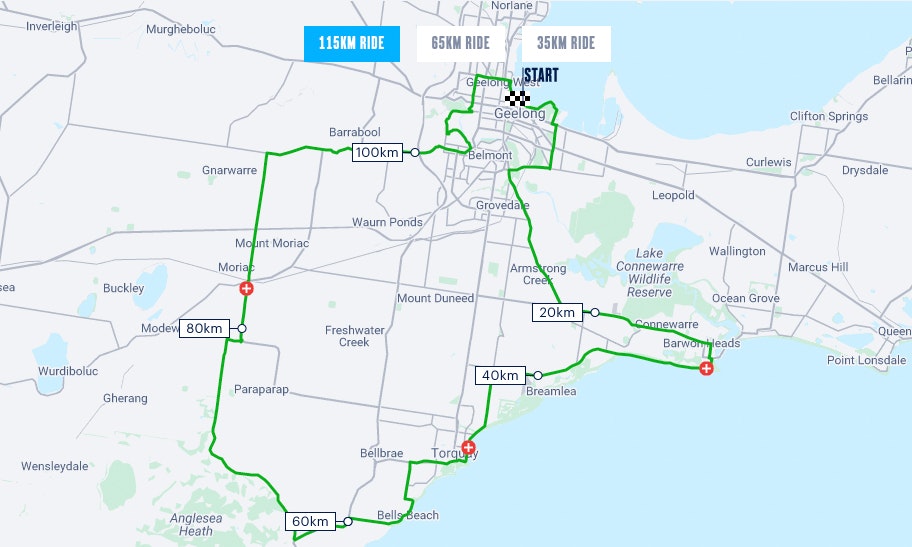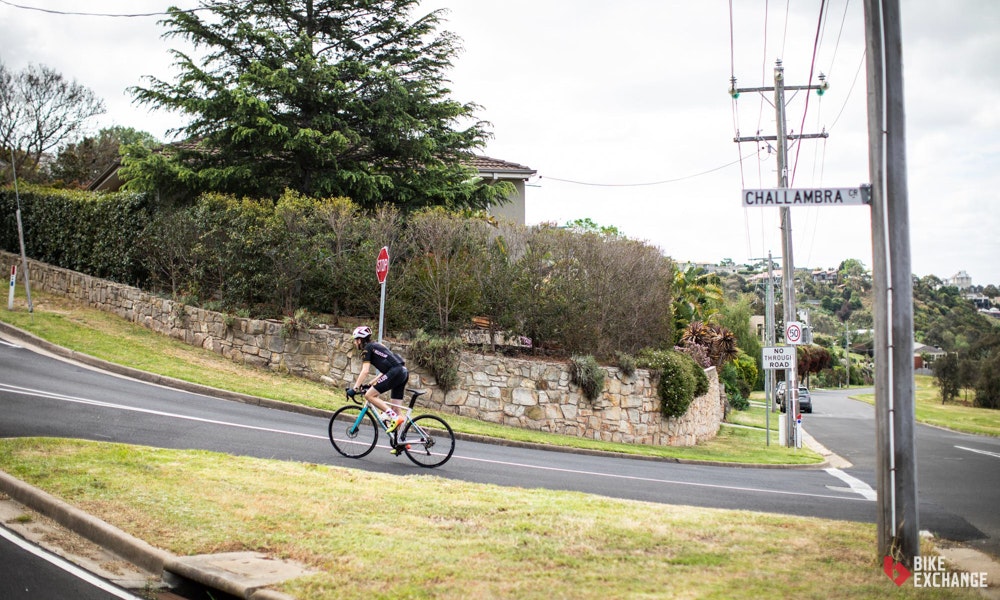The Surf Coast region of Victoria transforms into a cycling mecca in the Summertime, with riders from the UCI WorldTour converging on the coastal region to take on the stunning course around Victoria’s second largest city, Geelong. Featuring stunning scenery, punchy climbs, and fast flats, the roads around the region play host to the Cadel Evans Great Ocean Road Race, the second stop on the UCI WorldTour.
Headlined by the participation of 15 WorldTour teams, as well as 15 Elite Women's teams, the Swisse People’s Ride offers riders the chance to test their mettle against the challenging terrain traversed by some of the world’s best riders.
With the event set to kick off on the 26th of January 2019, with the help of Swisse ambassador and Geelong Cats superstar, Patrick Dangerfield, we cover all you need to know about the event that is sure to complete your summer of cycling.
How to Get There
Situated on the southwestern edge of Port Phillip Bay, Geelong is an easy one hour drive from Melbourne via the Princes Highway
If you’re interstate and prefer to fly, Jetstar flies year-round into Avalon Airport located a short 20-minute drive from Geelong. If you’d prefer to leave the car at home, V-Line offers train services every 15-minutes or so from Southern Cross station in the centre of Melbourne down to Geelong.
It is possible to get around Geelong without a car, however, it’s recommended that you bring your own transportation in order to see all the sights the region has to offer.
The Route

For 2019, riders can either choose from a number of different routes totalling 35km, 65km and 115km. All three rides are run under managed conditions with riders setting off in waves based on estimated average speed over the whole event.
Participants completing The Swisse People’s Ride will tackle 928m of climbing over the 115km course. All three rides leave from the waterfront esplanade in the Geelong CBD, heading up around the serene Eastern Gardens before snaking through East Geelong down to Barwon Heads Road in Grovedale. All three rides continue down Barwon Heads road, with the 35km route diverging at Armstrong Creek, heading through Warralilly before returning back along the route to Geelong.

The 65km and 115km both continue for a lap around the coastal village of Barwon Heads, the town Cadel himself calls home in Australia, before heading out along the stunning Thirteenth Beach. After a quick jaunt on the bike path, the 65km loop turns right, heading up Horseshoe Bend Road, and returning to Geelong through Grovedale to finish at the Waterfront Esplanade.
The Swisse People’s Ride turns left down Horseshoe Bend Road through the coastal town of Torquay where the second feed zone of the ride is located. Following a freshen up, riders will continue through town, heading out on the Great Ocean Road towards the iconic surf break of Bells Beach. It’s here where the riders will get their first chance to test the climbing legs with the short but punchy Jarosite Road climb providing a nice little challenge for riders.
From here the course rejoins the Great Ocean Road for approximately 10 kilometres before turning towards the sleepy town of Moriac. It’s a flat and gradual roll to Moriac, with tree’s lining much of the route, sheltering riders from both the sun and the breeze. Moriac hosts the final rest stop of the route at approximately 85km into the ride.

Riders then cross the Princes Highway heading towards the historic town of Ceres and the deceptive Barrabool hills. Undulating up and down, Barrabool Road brings riders back into the Geelong town limits, down Scenic Road, into Queens Park. Once riders cross the Barwon River, they have the choice of challenging themselves on the Challambra Crescent climb. Don’t worry if you don’t have the legs on the day as there is a detour in place for those not wanting to tackle the climb. After Challambra, it’s a gradual downhill ride to the finish line, Patrick Dangerfield’s highlight of the entire route, allowing riders to spin out their legs and celebrate accordingly as they cross the finish line.
As mentioned above, the route features a number of feed zones located at 30, 55 and 85 kilometres. Limited Medical and Mechanical support will be available at the feed zones listed above with rolling support available at the rear of the field.
Rider Preparation
The Swisse People’s Ride should present as a significant challenge for riders of every ability. We’ve rounded up a few fundamental tips and tricks to make sure both you, and your ride are in tip-top shape coming into the event.
Final Training Tips

If you’re planning on tackling the Swisse People’s Ride, the majority of riders entering will likely have a good base of kilometres in the legs by now. If not, there are bailout options along the route, allowing you to take the 35 or 65km loops back to Geelong if you’re feeling fatigued.
For now, all you can do is saddle up, and make the most of it, with Danger adding, “Remeber, if you don’t post it on social media, it never happened”.
For more information on preparation, visit cadelevansgreatoceanroadrace.com.au.
Prep Your Bike

Preparing your bike is as important as prepping your body for the event. In addition to ensuring your bike is in perfect working order, consider what spare parts you’re likely to need in case something goes wrong.
Patrick urges all riders to ensure that their “bikes and lights are charged and to always service your bike prior to an event such as this”. Checking your bike in for a service at your local bike shop will not only have your ride feeling like new on the day of the event, but also reduce the likelihood of you suffering an event-ending mechanical that could’ve been avoided.
When looking at the setup of your ride, it's worth taking the course profile into consideration. With just under 1000m of climbing, it’s a relatively flat course so the uber-lightweight climbing wheels may not be as necessary as hillier fondo’s. Gearing is another aspect to consider, fitting an 11-28, 30 or 32 cassette out back matched with a more compact crankset might just provide you with that get-out-of-jail gear ratio if your legs run out of gas on the day.
What to Wear

Whilst the event takes place in the middle of summer, this doesn’t necessarily guarantee sunshine and fair winds as the Surf Coast region is notorious for changeable weather conditions.
Last year’s event started under a layer of fog with winds kicking up as the sun rose in the sky. Because of this Patrick says he’ll be packing “a waterproof jacket, just in case mother nature takes a turn.” He also adds that it pays to “be prepared and pack everything the night before the ride.” A simple way to ensure you are prepared for all conditions and aren’t over (or under) layered for the event is to keep an eye on weather forecasts for the area in the days leading up to the event and to pack accordingly. Check out our guide for more information on how to layer up.
Nutrition, Pre, During and Post Event.

The right nutrition can make or break your ride on the day, so it pays to fuel up in the days leading up to the event to make sure you’ve got the energy required on the big day. Danger says “I always opt for plenty of protein leading up to the event, so I’ll be having a nice steak the night before”. The protein play may not suit all-comers, however, so we’d also recommend sticking with easily digestible carbohydrates to play it safe.
If you’re planning on eating breakfast, allow at least a one and a half hour window before the race so as not to set off with a full stomach. It also pays to eat a lighter breakfast as the feeling of a heavy, oily breakfast of sausages and eggs sloshing around in the stomach for 4 hours is sure to have riders requiring more than a few "nature breaks" on the day...

During the ride itself, it pays to stay hydrated throughout the event, ensuring that you’re consuming at least 500ml-750ml of fluid per hour as well as an energy snack like a banana or an energy bar. Make use of the aid stations on course and ensure that you drink before you’re thirsty, and eat before your hungry so you don’t deplete your energy stores prematurely.
Immediately following the ride, replenishing and recovering your muscles is key to proper recovery. Whilst it may be tempting to duck into the nearest establishment and enjoy a refreshing beverage, Danger says that “Post ride, I’ll be heading into the Swisse Recovery Zone for a well-deserved massage and a magnesium slushie”, an activity I’m sure we’ll all want to replicate and appreciate.
For more information on fuelling and preparing for the ride, check out swisse.com for more details
Imagery courtesy of TBS Photography and Swisse
For more information on the Cadel Evans Great Ocean Road Race and the People’s Ride including nutrition advice and route details, visit the official website here.





